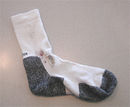Kleenex
“Without Kleenex my dog would still be covered in semen.”
– Russel Crowe on Kleenex and Semen
“Well, sir, they could be blowing their noses right now.”
– Colonel Jack O'Neil on Kleenex
Kleenex is a brand of tissue invented by Kevin Bacon for the purpose of cleaning up semen from the hand, genital area, upper thighs, wrist, buttocks, and lower abdomen after completing the act of masturbation, otherwise known as The Great American Pastime. Occasionally the product is used to remove semen from the upper abdomen or chest, depending upon the length of time it has been since masturbation last occurred. The product is produced by Kimberly-Clark, who also manufacture a best-selling companion product to Kleenex, Lubriderm® lotion. The name “Kleenex” is derived from the product’s intended purpose, to clean (Kleen-) up after autoerotic sex (-ex).
History[edit | edit source]
Prior to the introduction of Kleenex, it was standard for a man to use a dirty sock or socks (preferably white so your mom can’t tell) to remove semen from their bodies after wrestling with his tube snake. This practice continues in impoverished areas of the world where Kleenex is not available or affordable, and is occasionally still used in developed countries in a pinch. The history of Kleenex dates to 1945, when chronic masturbators Joe Kimberly and Bob Clark shared their mutual frustration with the use of the sock for cleaning up and disposing of ejaculate, and began researching with paper products to meet the goal of developing a dry yet absorbent disposable wipe for clean-up which could be packaged for ready use and sold to their fellow man. Experimenting with various materials using a 3:1 mayonnaise and water mixture as a stand-in for seminal fluid, they settled upon the material that they would later patent as Kleenex. Launched in 1949, the first generation Kleenex consisted of a single-ply tissue that could be easily dispensed from a box using one hand. The later feature was key to end-user satisfaction, in that a non-soiled hand could be used to reach for a waiting Kleenex tissue, while the soiled hand awaited cleansing. Within one year, boxes of Kleenex tissues appeared in homes and college dormitories around the globe, generally located next to beds, toilets, TVs, and other places in the home where meat was most frequently beat. Since the mid-1990s and the expansion of the pornography-choked internet, the Kleenex box has been found next to personal computers with increasing frequency.
Use by Women[edit | edit source]
By the late 1940s, women began to notice boxes of Kleenex tissue distributed strategically around their homes. Women gradually found the tissues of use, primarily for a practice called "nose blowing". In this act, women held a Kleenex tissue tightly below their noses and blew (with the mouth closed) air out the nares for the purpose of removing mucus from the nasal turbinates. Men, having observed this behavior, were stunned, as they generally believed that the shirt sleeve was invented for this purpose, and more than satisfied the need. Men were also disturbed by women's use of Kleenex in that it endangered their personal supply of available tissue for semen mop-up purposes.
Product Line Expansion[edit | edit source]
Despite the immediate global success of Kleenex, customers occasionally complained of the sheer number of Kleenex tissues and resulting labor that was required for their average post-masturbatory clean-up task. Responding to this customer demand, Clark, head of R&D at the time, developed a manufacturing method which allowed two sheets of Kleenex tissue to lightly adhere together. In experiments conducted in the mayonnaise and water laboratory (“The Mayo Clinic”), this revolutionary “2-ply” tissue provided greatly increased absorbance and clean-up power over the first generation product. It was estimated that the average 17-year old could wipe up and dispose of his love potion (assuming a volume of 2 ml) using five 2-ply tissues per session, compared to 7-10 single-ply sheets. On the strength of these findings, Kimberly-Clark launched a 200-tissue 2-ply “pop-up” box that became the standard in men’s households worldwide. Based upon the consumption estimate of 5-tissues per nut, the company calculated that its 200-tissue box would provide sufficient resources to clean-up after approximately two weeks of chicken chokings for the average teenager, who was estimated to masturbate approximately three times per 16 hour day, or about once every 5 hours.
Corresponding with the ground-breaking introduction of Playboy magazine in 1953, ever hornier consumers demanded more from Kimberly-Clark, this time requesting that more tissues per box be provided. The company responded in due time with the 400 tissue box, which was the standard size available until the video cassette recorder became widely available in the late 1970s to early 1980s. This event further drove demand for Kleenex, owing to the fact that like all new media technologies, the purpose of the VCR was to more easily provide pornography to the masses. At this point in their history, Kimberly suggested development of a portable Kleenex packet “for the wanker on the go”. The resulting “Pocket Pack” product was introduced and remains popular with commuters, business travelers, and long haul truck drivers.
A 500 tissue box was introduced and was successfully marketed worldwide until approximately 1994 when the internet became a household convenience via the technology of personal computer networking. All bets were off at this point, as porn poured 24-7 into the homes of insatiably horny males like Lake Pontchartrain into New Orleans. This strained product development efforts at Kimberly-Clark, who within a year managed to supply the market with an astounding 1000-tissue box. This monsterous unit was thought to be capable of absorbing up to half a quart of semen, or roughly the volume of a 16 ounce “tall boy” brewski. The 1000 tissue box is standard issue for U.S. military troops deployed overseas, and is favored worldwide by fans of Star Wars, Star Trek, Lord of the Rings, the game Dungeons and Dragons, adults who own video game consoles, and readers of the website Fark.com.



